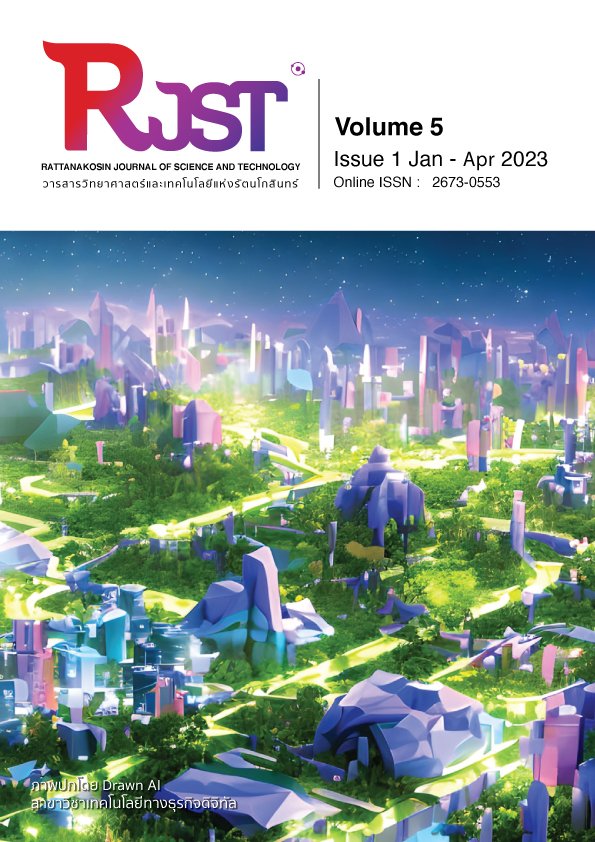Development of Systems for Determination of Nutrients in Thai Foods by Thin Layer Chromatography
Main Article Content
Abstract
Thin layer chromatography (TLC) was employed for detecting nutrients in Thai food and the results from TLC were evaluated by TLC densitometry technique. Three optimized systems for analyzing three groups of each nutrients i.e. essential oils, polar compounds and amino acids were developed. The optimized conditions for analyzing essential oils were as follows; the solvent for extraction was chloroform, the stationary phase was silica gel 60F TLC plate, the mobile phase system was toluene: ethyl acetate (85:15). The developed TLC plate was then subjected to derivatize by iodine and the efficiency for nutrient separation was visualized by photo documentation under UV light at 254 nm. The optimized conditions for polar compounds were as follows; the solvent for extraction was formic acid or distilled water, the stationary phase was silica gel 60F TLC plate, the mobile phase system was ethyl acetate: formic acid: acetic acid: water (100: 11: 11: 26). The efficiency of nutrient separation was evaluated by visualization under UV light at 366 nm. The optimized conditions for standard amino acids were as follows; the stationary phase was silica gel 60F TLC plate, the mobile phase system was n-butanol: acetic acid: water: methanol (4: 1: 1: 1). The developed TLC plate was subsequently derivatized by iodine and Ninhydrin solution. The efficiency of nutrient separation was evaluated by visualization under visible light. In addition, results from TLC densitometry indicated that there was a similarity in absorption spectrum among amino acids with the same polarity whereas their Rf values were different, suggesting that the developed system was specific for analyzing amino acids.
Article Details

This work is licensed under a Creative Commons Attribution-NonCommercial-NoDerivatives 4.0 International License.
The content within the published articles, including images and tables, is copyrighted by Rajamangala University of Technology Rattanakosin. Any use of the article's content, text, ideas, images, or tables for commercial purposes in various formats requires permission from the journal's editorial board.
Rajamangala University of Technology Rattanakosin permits the use and dissemination of article files under the condition that proper attribution to the journal is provided and the content is not used for commercial purposes.
The opinions and views expressed in the articles are solely those of the respective authors and are not associated with Rajamangala University of Technology Rattanakosin or other faculty members in the university. The authors bear full responsibility for the content of their articles, including any errors, and are responsible for the content and editorial review. The editorial board is not responsible for the content or views expressed in the articles.
References
Krisha Veni, N., Kartika, D., Surya, Devi M., Rubini, MF., Vishalini, M., and Pradeepa, YJ. (2010). Analysis of monosodium I glutamate in food products by high performance thin layer chromatography. J Young Pharm, 2(3), 297-300. https://doi.org/10.4103/0975-1483.66795
Melock, GE., Meyer, S., Zimmerman, BF. and Roussel, GM. (2014). High-performance thin-layer chromatography analysis of steviol glycosides in Stevia formulations and sugar-free food products, and benchmarking with (ultra) high-performance liquid chromatography. J Chromatogr A, 1350, 102–111. https://doi.org/10.1016/j.chroma.2014.05.016
Andradea, F., Guedesb, MIF., Vieirac, IGP., Francisca, Mendesc NP., Rodriguesd, PAS., Maiab, CSC., Ávilaa, MMM., Ribeiroe, LM. (2014). Determination of synthetic food dyes in commercial soft drinks by TLC and ion-pair HPLC. Food Chem, 157, 193–198. https://doi.org/10.1016/j.foodchem.2014.01.100
Vongchareonsathit, A. De-Eknamkul, W. (1998). Rapid TLC-densitometric analysis of Plaunotol from Croton sublyratus leaves. Planta Med, 64, 279-280. https://doi.org/10.1055/s-2006-957428
Merck Millipore. (2016, January). Chemicals and reagents 2008–2010.
http://www.merckmillipore.com/TH/en/20140402_111401
Huba, K. Mária, B. Klára L., V. (2020). Chapter 10 - Basis and pharmaceutical applications of thin-layer chromatography. Handbook of Analytical Separations. 8, 523-585.
Merck Millipore. (2016, January). RP-modified Silica Plates. https://www.merckmillipore.com/AU/en/products/analytics-sample-prep/chromatography-for-analysis/thin-layer-chromatography/tlc-plates-thin-layer-chromatography/rp-modified-silica-plates/rdmb.qB.ITwAAAFAjvtkiQpx,nav
Andriy, C. Tor, S. Jerker, W. (2010). Iodide as a Fluorescence Quencher and Promoter-Mechanisms and Possible Implications. J. Phys. Chem. B., 114 (34), 11282-11291.


